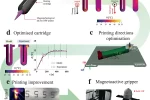
New In-Silico Framework for 3D Printed Conductive Polymers
3dprintingindustry.com
A new in-silico platform developed by researchers from University Carlos III of Madrid, Imperial College London, University of Oxford, and BCMaterials provides a multi-scale computational framework for evaluating the thermo-electro-mechanical properties of 3D printed conductive components. The model integrates material composition, printing parameters, and external conditions into a predictive tool that simulates how conductive polymer composites (CPCs) behave under electrical, thermal, and mechanical stress.Fused Filament Fabrication (FFF) introduces structural variations at the microscale, impacting a materials conductivity and mechanical integrity. While previous research has examined individual factors such as electrical resistance changes or mechanical stress effects, this new approach synthesizes these interactions into a unified framework, enabling precise design adjustments to optimize functional performance.Multi-physical characterisation of FFF samples with different printing orientations. Image via Nature.Conductive thermoplastics are composed of polymer matrices embedded with conductive fillerssuch as carbon blackforming networks that allow electric current to flow. However, the conductivity of these networks depends on filament deposition patterns and inter-filament adhesion quality. The study found that printing orientation, layer height, and adhesion strength significantly affect key properties, including resistivity, strain sensitivity, and Joule heating.Experimental validation showed that longitudinally printed samples, where filaments align with the electrical field, exhibited lower resistivity and greater mechanical resilience. In contrast, transverse samples, with filaments perpendicular to the electrical load, had higher resistance due to disrupted conductive pathways and weak inter-filament bonding.In-silico multiscale platform for conductive thermoplastics. Image via Nature.Mechanical behavior also changes with printing direction. Longitudinal samples displayed a linear increase in resistivity under mechanical stress, while transverse samples had a more erratic response, influenced by localized strain concentrations in void regions. These findings reinforce the importance of strategic filament deposition in the design of conductive 3D printed components.Bridging Mesoscopic and Macroscopic PropertiesThe in-silico platform incorporates a multi-scale modeling framework, enabling predictions on how mesostructural voids and inter-filament adhesion influence bulk material properties. At the mesoscopic level, a full-field homogenization model quantifies the behavior of individual printed filaments, while a macroscopic continuum model accounts for Joule heating effects, thermal expansion, and mechanical deformation under real-world conditions.By linking these scales, the framework eliminates the trial-and-error process in experimental testing. Engineers can now adjust parameters such as extrusion width, layer height, and print speed to optimize conductivity and mechanical stability before fabrication begins.Predictive capabilities of the multi-physical in-silico platform. Image via Nature.Prior studies have investigated how printing defects affect mechanical properties and separately analyzed electro-thermal and mechano-electrical responses in conductive polymers. However, no previous work has systematically linked these factors into a single predictive model.Conductive pathways in CPCs rely on percolation networks of conductive fillers, but FFF introduces additional factorsvoid formation, imperfect adhesion, and filament alignmentthat modify electrical resistance and mechanical performance. The new framework accounts for these mesostructural disruptions, providing a more accurate prediction of electrical resistance, mechanical failure, and thermal conductivity over time.Full-field homogenisation analysis of 3D printed conductive thermoplastics at the mesoscale. Image via Nature.Optimizing 3D Printed Components and Future ApplicationsA key validation test for the model involved optimizing a 3D printed electro-heatable printing cartridge for Direct Ink Writing (DIW) printers. This component regulates ink viscosity through Joule heating, where an applied electrical current generates controlled heat.Initial designs produced uneven temperature distributions, with overheating near the electrode contact points and insufficient heating in other areas. Using the in-silico framework, researchers optimized the filament deposition strategy to distribute electrical potential more evenly. The final design demonstrated improved thermal regulation, ensuring consistent ink viscosity control and eliminating defects caused by uneven heating.Application of the in-silico platform to the optimal design of a 3D printed heatable cartridge for DIW printers. Image via Nature.This computational-experimental hybrid framework provides a valuable tool for additive manufacturing engineers designing 3D printed electronic components, wearable sensors, and smart materials. The ability to simulate and optimize multifunctional responses before fabrication could lead to advancements in aerospace, biomedical devices, and flexible electronics.By linking microscale material behavior to large-scale structural properties, this in-silico platform provides a systematic approach to conductive polymer design. Future research may expand the model to composite materials with alternative conductive fillers, such as graphene or silver nanowires, broadening its applicability to next-generation electronic and structural components.3D Printing Industry is hosting alive webinar to preview the 2025 AMUG Conference. Join us and our guests on Wednesday, 12th February.Ready to discover who won the 20243D Printing Industry Awards?What will the future of 3D printing look like?Which recent trends are driving the 3D printing industry, as highlighted by experts?Subscribe to the 3D Printing Industry newsletter to stay updated with the latest news and insights.Stay connected with the latest in 3D printing by following us on Twitter and Facebook, and dont forget to subscribe to the 3D Printing Industry YouTube channel for more exclusive content.Featured image shows application of the in-silico platform to the optimal design of a 3D printed heatable cartridge for DIW printers. Image via Nature.
0 Yorumlar
·0 hisse senetleri
·56 Views


